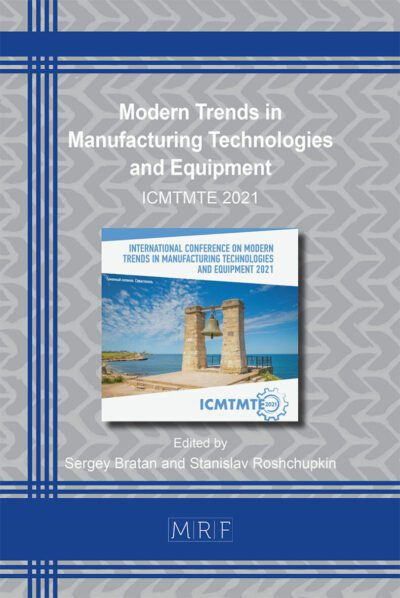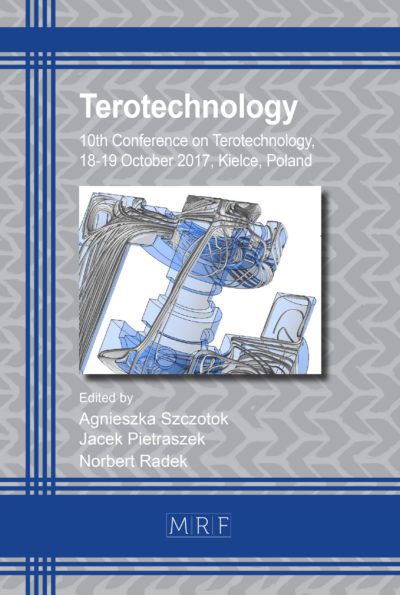Accomplishing functional requirements of a device used in testing perforation resistance of a 3D printed part
Mihaela NICOLAU, Laurențiu SLĂTINEANU, AndreeaI STRATE, Marius-Andrei MIHALACHE, Oana DODUN
Abstract. Sometimes, for various reasons, some 3D printed parts need to be designed for certain levels of perforation resistance. A typical perforation test is performed with a conical tipped indenter, which is allowed to fall under its own weight on the test specimen. Depending on various factors, the conical tip will penetrate and advance more or less into the specimen material. Such factors are the height from which the penetrator is released, the mass of the penetrator, and the thickness of the specimen. Previously, a device was designed and tested that provides conditions for testing the perforation resistance of 3D printed plastic parts. In such conditions, it was considered of interest to verify the extent to which the device corresponds to the functional requirements for which it was designed, by using some principles from axiomatic design. Principles from axiomatic design were used to verify the solution adopted in the case of the device for testing the perforation resistance of some plastic samples manufactured by 3D printing, Ultimaker 3 printer (Netherlands). To this end, zero-order, first-order and second-order functional requirements have been defined. Solutions were analyzed to adequately address the various functional requirements. By using principles from axiomatic design, the extent to which the various functional requirements for the testing device were met was verified. Ways to improve the use of the device for testing the perforation resistance of 3D printed plastic parts have been identified.
Keywords
Plastic Materials, 3D Printing, Perforation Resistance, Axiomatic Design
Published online 5/7/2025, 8 pages
Copyright © 2025 by the author(s)
Published under license by Materials Research Forum LLC., Millersville PA, USA
Citation: Mihaela NICOLAU, Laurențiu SLĂTINEANU, AndreeaI STRATE, Marius-Andrei MIHALACHE, Oana DODUN, Accomplishing functional requirements of a device used in testing perforation resistance of a 3D printed part, Materials Research Proceedings, Vol. 54, pp 2075-2082, 2025
DOI: https://doi.org/10.21741/9781644903599-223
The article was published as article 223 of the book Material Forming
![]() Content from this work may be used under the terms of the Creative Commons Attribution 3.0 license. Any further distribution of this work must maintain attribution to the author(s) and the title of the work, journal citation and DOI.
Content from this work may be used under the terms of the Creative Commons Attribution 3.0 license. Any further distribution of this work must maintain attribution to the author(s) and the title of the work, journal citation and DOI.
References
[1] Information on https://webstore.ansi.org/
[2] Information on https://advanses.com/mechanical-testing-of-3d-printed-parts-and-materials/
[3] F. Lambiase, S.I. Scipioni, A. Paoletti, Mechanical characterization of FDM parts through instrumented flat indentation, Int. J. Adv. Manuf. Technol. 125 (2023) 4201-4211. https://doi.org/10.1007/s00170-023-10992-3
[4] Information on https://sn.astm.org/features/5-most-important-standards-additive-manufacturing-.html#:~:text=Although%20it%20has%20since%20been,is%20still%20in%20use%20today.
[5] J. Alcisto, A. Enriquez, H. Garcia, S. Hinkson, T. Steelman, E. Silverman, P. Valdovino, H. Gigerenzer, J. Foyos, J. Ogren, J. Dorey, K. Karg, T. McDonald, O.S. Es-Said, Tensile Properties and Microstructures of Laser-Formed Ti-6Al-4V, J. Mater. Eng. Perf. 20 (2011) 203–212. https://doi.org/10.1007/s11665-010-9670-9
[6] F. Alisafaei, C-S. Han, Indentation depth dependent mechanical behavior in polymers. Adv. Condens. Matter. Phys. (2015) 1-20. https://doi.org/10.1155/2015/391579
[7] A. Girgenti, A. Giorgetti, M. Anselmi, A. Scatena, Improvement of the test equipment for a stress corrosion lab through the Axiomatic Design, Procedia CIRP 34 (2015) 162-167. https://doi.org/10.1016/j.procir.2015.07.067
[8] I.M. Boyle, K. Rong, D.C. Brown, CAFixD: a case-based reasoning fixture design method, Proc. SPIE 5263, Intelligent Manufacturing (2006) https://doi.org/10.1117/12.521008
[9] M. Nicolau, A. Hrituc, M.-A. Mihalache, G. Nagît, P. Dușa, E. Crăciun, A. Munteanu, O. Dodun, L. Slatineanu, Perforation resistance of some materials in 3D printed parts, Materials Research Proceedings 41 (2024) 2514-2523. https://doi.org/10.21741/9781644903131-277
[10] N.P. Suh, Axiomatic Design: Advances and Applications, Oxford University Press, New York, 2001. https://doi.org/10.1016/S0142-694X(02)00058-3














